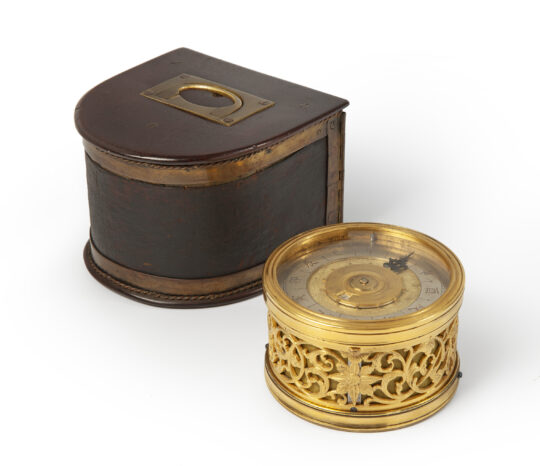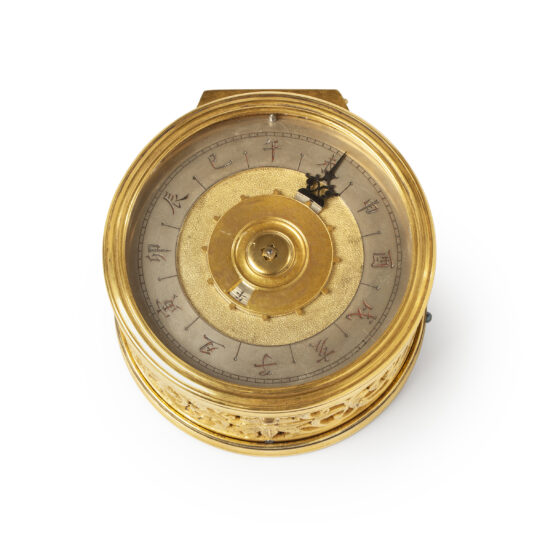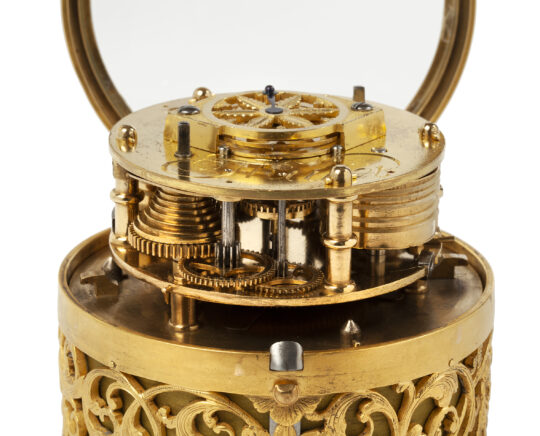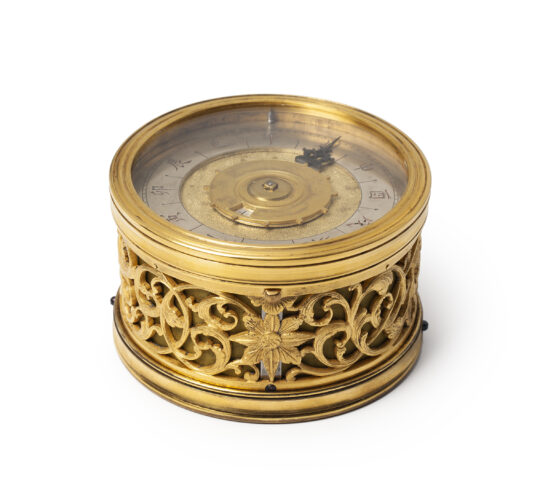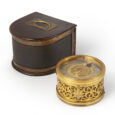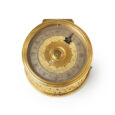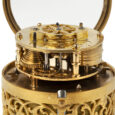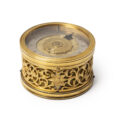CHINESE DRUM CLOCK WITH SILVERED DIAL AND TRAVELLING CASE Circa 1830
M&R272
DRUM CLOCK WITH SILVERED DIAL AND TRAVELLING CASE
Circa 1830
China
Movement
The circular, spring-driven brass movement consists of a going train, balance and hairspring regulation as well as an alarm. The going train has spring barrel with chain fusee, a verge escapement with hairspring balance and regulation. The backplate is elaborately engraved depicting leaf and vine motifs and has a pierced balance cock showing floral motifs and the signature Thuret a Paris. The movement is wound from the bottom.
Dial
The matted brass dial plate has a slightly curvaceous white enamel chapter ring with the twelve Chinese signs of the zodiac. Each sign represents two hours and is divided in eight parts forming a quarter-hour ring. The time is indicated by a single pierced silvered brass hand. In the centre is a firegilt brass alarm disc. Under this disc is a silvered fixed disc, which is engraved depicting the twelve signs of the zodiac. These signs appear in the aperture in the alarm disc and become one by one visible when the disc is turned, thus setting the alarm time. The dial is protected by a convex glass set in a firegilt brass hinged bezel.
Case
The cylindrical firegilt brass case, of which the circumference is pierced and engraved, depicts various images such as fish, shell motifs and some fantasy motifs. In the bottom are two winding holes for both the going train and the alarm. The hinged bezel is marked on the inside with a Chinese character.
Travelling case
The original wooden travelling case, which protects the clock while travelling, is covered on the outside with leather and has a brass handle.
Duration: one day
Height: 8 cm.
Diameter: 11.5 cm.
Literature
– The Seiko Timepiece Collection, Museum Tokyo, p. 87.
– Clock and Watches of the Qing Dynasty, . 40.
Note:
This clock is Chinese, from the Qing dynasty and the Qianlong period. The openwork decoration with Buddhist emblems is very characteristic of Chinese work. In addition, there are two very similar models in the Seiko museum in Tokyo (watchmaking museum) and these two models are also Chinese from the Qing period. There is also a comparable clock in the collection of the Sundialfarm.
Qing Dynasty:
The Qing dynasty, also known as the Manchu dynasty, was the last imperial dynasty of China. It succeeded the Ming dynasty in 1644 and was itself replaced by the Republic of China in 1912. The dynasty originated in Manchuria with the Aisin Gioro, one of the many clans that lived in the area.
Bron: Wikipedia
Qianlong periode:
The Qianlong Emperor (25 September 1711 – 7 February 1799), also known by his temple name Emperor Gaozong of Qing, born Hongli, was the fifth emperor of the Qing dynasty and the fourth Qing emperor to rule over China proper, reigning from 1735 to 1796. The fourth son of the Yongzheng Emperor, he reigned officially from 11 October 1735 to 8 February 1796. In 1796, he abdicated in favour of his son, the Jiaqing Emperor, out of filial piety towards his grandfather, the Kangxi Emperor, who ruled for 61 years, so that he not officially usurp him as the longest-reigning emperor. Despite his retirement, however, the Qianlong Emperor retained ultimate power as the Emperor Emeritus until his death in 1799, making him one of the longest-reigning monarchs in history, and dying at the age of 87, one of the longest-lived.
Source: Wikipedia

